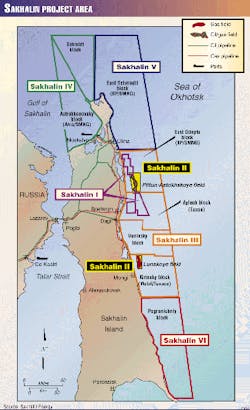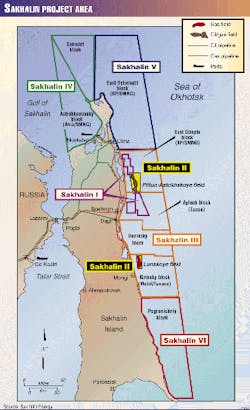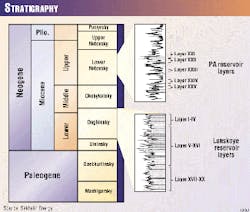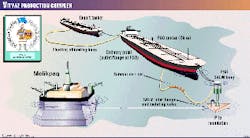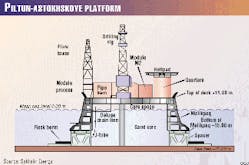Sakhalin Energy Investment Co. Ltd. (Sakhalin Energy) expects to begin production this month in the Sea of Okhotsk, becoming the first company to develop a Russian offshore field.
The company will also become the first foreign enterprise to develop oil and gas resources in Russia under the new production-sharing agreement (PSA).
There are two Sakhalin II PSA License Areas, each covering a large field discovered in the 1980s.
Field development
The Lunskoye and Piltun-Astokhskoye fields contain combined reserves of about 1 billion bbl of liquids and 14 tcf of gas (Fig. 1). Lunskoye is capable of supplying a peak production rate of 1.5 bcfd, sufficient to support a plant producing over 9 million metric tons/year of LNG.
The reservoirs in the field are comprised of deltaic and shallow-marine sandstones of the Early to Middle Miocene Daghinsky formation (Fig. 2). Thick sandstone layers, covering 1,300 ft of vertical section, characterize the Daghinsky formation.
With a net-to-gross ratio of 75%, this gives an average reservoir net pay of 1,000 ft. This thick structure, together with high permeability, results in high delivery capacity, with individual production rates of 160 MMscfd. Sixteen reservoir layers are hydrocarbon bearing, of which 15 have been proven to be productive by drill stem tests. Typical pay thickness per layer is about 100 ft.
The reservoirs at Piltun-Astokhskoye include shallow-marine sands of the Upper Miocene Nutov formation.
Each sand layer is made up of interbedded sands and silts usually dominated by fine to medium-grained sandstone. Ten sand layers contain oil with or without gas caps, while one layer is gas bearing. Typical pay thickness ranges from 20 to 100 ft.
Altogether, hydrocarbon production could ultimately reach 200,000 b/d of liquids and 2 bcfd of gas, once both fields are fully developed.
The development of these hydrocarbon resources will require a unique combination of engineering and multinational teamwork. Work on this challenging project began with Phase I of the P-A (Piltun-Astokhskoye) field development, as described in the following.
Vityaz production complex
- The first of Sakhalin Energy`s offshore facilities-the Vityaz Production Complex-consists of three primary components that required a design and construction period of just 2 1/2 years (Fig. 3), at a total project cost of $685 million.
The Sakhalinskaya Oblasts regional governor, Igor Farkhutdinov, helped Sakhalin Energy find an appropriate identification for the new complex, naming it Vitgaz-the "Honorable Warrior." This name highlights Russia`s view of this vital project.
The complex includes a:
- Production platform PA-A, located in the Astokh portion of the Piltun-Astokhskoye field, about 12 km northeast of Sakhalin Island
- Single-anchor leg-mooring (SALM) buoy
- Floating-storage offloading (FSO) tanker.
To provide additional accomodations and work space for the hook-up and commissioning of the process facilities on the platform, the jack up drilling rig Sakhalinskaya has been temporarily positioned alongside, connected by a gangway. The equipment, materials, and personnel required to "frac pac" the first group of producing wells will be located aboard Sakhalinskaya, reducing interference with the hook-up and completion work on the production platform.
The Molikpaq
The PA-A (Piltun-Astokhskoye, Platform A) platform is a modified and refurbished Arctic-class drilling rig, known as Molikpaq, mounted on a steel spacer to elevate the platform. (Figs. 4 and 5). Molikpaq was first designed for Gulf Canada, as a bottom-founded mobile drilling unit for drilling in the shallow, ice-covered waters of the Canadian Beaufort Sea.
As early as 1993, the Sakhalin II team began studying Molikpaq as a possible economic solution for achieving early production from the Piltun-Astokhskoye oil field. This rig was selected mainly because its former operating environment in the Beaufort Sea, closely matched that of the Sea of Okhotsk.
Molikpaq, built in 1984, had been mothballed since 1990, but the Sakhalin Energy survey team found it in good overall condition. Independent surveys performed by the Classification Society, American Bureau of Shipping (ABS), and Russian experts also declared Molikpaq to be structurally sound and fit-for-purpose.
Nevertheless, Molikpaq`s new working environment necessitated redesign in some key areas. This included:Nevertheless, Molikpaq's new working environment necessitated redesign in some key areas. This included:
- The addition of a substructure necessary to elevate Molikpaq above sea level in the deeper waters of the Sea of Okhotsk.
- Structural improvements to support drilling up to 32 wells to measured depths of 6,000 m.
- Extensions to the rig's wave deflectors.
Conversion of the mobile exploration drilling rig to a permanent drilling and production platform required the addition of a 2,600 metic ton processing module to stabilize 90,000 bo/d for export and to treat and compress 70 MMcfd of produced gas for reinjection into the reservoir, until gas export commences Seismic activity, wave loading, wave run-up, and ice conditions represented the major metocean and environmental conditions that would affect Molikpaq`s arctic platform design. These issues dictated the requirements for model testing to ensure its structural integrity in its new environment.
The Sakhalin project team first applied physical hydraulic models to evaluate the feasibility of deploying Molikpaq in this severe metocean setting. The models then assisted in adapting and optimizing the platform design.
Sand berms had been used to elevate Molikpaq on previous deployments in the Beaufort Sea; however, it was questionable whether the large quantities of sand and rock required for a berm could be installed during the Sea of Okhotsk`s short weather window. Sakhalin Energy also wanted to minimize the environmental impact of dredging.
Spacer
As a result of these considerations, the decision was made to construct a steel spacer between the sea floor and Molikpaq (Fig. 5). Model tests proved that such a structure, engineered for the environmental conditions, would provide better wave-loading characteristics than a sand berm.
The Rubin Central Design Bureau for Marine Engineering in St. Petersburg designed the spacer while the Amur Shipbuilding Plant fabricated the 14,200 metric ton spacer. Prefabrication of the four block sections was carried out in Komsomolsk and final welding of the spacer was completed after transportation down the Amur River to Bolshoi Kamen.
The octagonal-shaped spacer measures 110 x 110 m and included three temporary stability towers and a hydraulically operated valve system for gravity ballasting, removed after mating with Molikpaq.
Seven J-tubes were installed for oil and gas risers, water injection, pipeline, and umbilicals. The spacer design met the Russian Maritime Register of Shipping (RMRS) requirements. Additionally, the American Bureau of Shipping (ABS) reviewed the design with conformance calculations abiding by their Mobile Offshore Drilling Unit Classification Rules.
Top side
In parallel with the spacer design and fabrication, the design and fabrication of the top-side modifications were also undertaken. These essentially consisted of a new process module needed to accommodate oil-treatment equipment for up to 90,000 bo/d, plus facilities for gas injection and oil export to the FSO vessel.
To further accommodate the required 32 well slots, extensions were made to the existing 8-slot arrangement. The drilling unit was also raised 5 m to provide space for production wellheads that were not required for Molikpaq`s previous service in Canada.
To withstand the high wave-slamming forces in the Sea of Okhotsk, the existing wave deflectors were also redesigned and significantly enlarged. To overcome abrasion from ice flows for 6 months of the year, an 8-mm carbon steel plate was added to the caisson structure`s ice-abrasion zone. Additional stiffening was also provided for earthquake loading.
J. Ray McDermott Engineering LLC and Tri Ocean Engineering Ltd. performed the detailed design of these top-side additions along with designing the refurbishment work in the drilling area. Sandwell Engineering Co. designed the wave deflector modifications. The fabrication and refurbishment work was contracted to Daewoo Heavy Industries in Okpo, South Korea, under separate competitive tenders.
Molikpaq`s outdated safety systems were also replaced and upgraded with newer technologies. These included additional fire-fighting and emergency-escape capabilities and the addition of a temporary safe refuge. Similarly, existing telecommunication systems were replaced with new equipment.
Generally, the drilling equipment was in good condition although it was necessary to replace or refurbish some equipment. This included replacement of the shale shakers, diverter system, top drive, cementing unit, and the wire line logging unit. The drawworks and rotary table were refurbished and the blow-out preventer was upgraded.
After review by Russian Institutes, the drilling rig and wellheads were further elevated to provide additional blast relief as a risk-reduction measure. This required elevating two of Molikpaq`s three main pedestal cranes to maintain structural clearance.
Narrow weather windows
Arctic conditions placed strict limitations on the project schedule. For example, the project had several narrow weather windows for towing activities, that if missed, could have delayed the project by a full year.
First, Molikpaq itself had to be towed more than 4,000 nautical miles from the Canadian Beaufort Sea to the shipyard in Okpo, South Korea. It was also necessary to tow the spacer sections down the Amur River to Bolshoi Kamen for assembly before it froze over in the autumn of 1997.
In May 1998, the spacer was again towed to a carefully selected mating site and submerged by flooding the main ballast tanks while maintaining trim and heel control with the corner tanks. Molikpaq was then towed to the mating site and slowly winched into position over the spacer.
Once in position, the spacer was deballasted, raising Molikpaq out of the water and allowing workers to permanently weld the sections together. The final footprint position of Molikpaq, in relation to the spacer, was well within the specified 50-mm tolerance. Once mated, the Molikpaq and spacer weighed 51,600 metric tons.
Site preparation
In August 1998, the onshore refurbishment of Molikpaq was completed and it was towed 1,495 nautical miles through the Sea of Japan to the Piltun-Astokhskoye platform location.
Before installation, the proposed location had to be dredged, back-filled, and leveled to form a satisfactory foundation. Sand quality had to be maintained and monitored round the clock by specialists who made visual assessments of the particle sizes and content.
In addition, laboratory testing was performed to confirm the visual assessments. A total volume of around 300,000 cu m of sand was used.
Despite high winds and stormy seas resulting from typhoon Rex, Molikpaq was installed Sept. 1, 1998, within 5 m of its design location, beginning its new life as the PA-A platform.
To complete the installation of the PA-A platform, the center core of the caisson was filled with sand to provide resistance against horizontal ice loads. A total volume of more than 200,000 cu m of sand was used to fill the caisson core.
To ensure adequate stability of the core in dynamic loading events, explosive densification was carried out by Foundex Explorations Ltd.
This method was successfully used when Molikpaq was originally deployed in the Beaufort Sea. Close attention to detail became a critical issue, ensuring that no damage occurred to the top-side equipment and structure while achieving sufficient explosive energy into the sand. A licensed Russian blasting contractor, OAO Transvzryvprom, performed the handling of the explosives, requiring Russian approvals.
Scour protection
A scour-protection system was required to provide external structural resistance to currents and storm waves. A stacked design using more than 20,000 metric tons of three different grades of rock was selected based on model testing.
Sacrificial amounts of marine gravel were also placed at two locations some distance away from the eastern corners of the PA-A platform, assessed to be the most severe location for seabed scour. All rock dumping was performed by Van Oord ACZ`s dynamically positioned, flexible fall-pipe vessel, Rocky Giant.
SALM
In parallel with the core filling and scour protection activities, the hook-up and commissioning team commenced its offshore scope of work to complete outstanding construction work and to commission the platform systems.
Also, in parallel, the remaining part of September 1998 was taken up with installation of the SALM, riser, and oil-export pipeline. The lay barge Yamashiro was contracted by Van Oord to perform this work.
The SALM is provided by Sakhalin Marine Ltd. (SML). Prior to installation, a "glory hole," or sunken depression, had to be excavated in the seabed to ensure that the top of the SALM buoy would remain below the maximum expected ice-keel depths during winter storage.
Once the ice thawed at the start of the 1999 summer season, final commissioning of the SALM was completed.
FSO vessel
The final piece of equipment needed to complete the Vityaz Production Complex was the FSO vessel Okha. Okha `s construction commenced in June 1998 at Daewoo`s Heavy Industries shipyard, Okpo, South Korea, and was completed in March 1999.
The double-hulled Okha, with 12 storage tanks capable of holding 1 million bbl, includes a reinforced bow that allows it to push through young or light ice. Tandem offloading can be performed from the stern.
Okha is one of the few vessels worldwide that can operate both as a floating storage unit and as a tanker.
Russian teamwork
Sakhalin Energy, consisting of Marathon Sakhalin Ltd., Mitsui Holdings B.V., Sakhalin Development Co. Ltd., Shell Sakhalin Holdings B.V., and Diamond Gas Sakhalin B.V. (Mitsubishi), will become the first group to achieve production under terms of a Russian production sharing agreement (PSA).
A requirement of the PSA is that Sakhalin Energy must use its best efforts to maximize Russian content to achieve the target of 70% over the life of the entire Sakhalin II project. This is subject to Russian enterprises meeting agreed qualifications, including price, quality and schedule.
Calculated over the life of the fields, Russian content applies across the whole spectrum of activities, including the supply of material and equipment, labor, and construction operations, all of which are closely monitored by Sakhalin Energy.
A significant contribution to the Phase I portion of the Russian content came from the fabrication of the spacer, which was done entirely in Russia. This work was finished ahead of schedule while achieving excellent quality and dimensional accuracy.
Committed to achieving a high Russian content ratio, the Sakhalin Energy engineering team will continue to study ways to maintain a high level of Russian content for the subsequent phases of Sakhalin II`s development.
Approval procedures
In moving forward with this unique development, Sakhalin Energy overcame many challenges. In particular, the Russian approvals process presented numerous complexities for the Sakhalin II team.
To succeed in developing the Piltun-Astokhskoye hydrocarbon resources, the project team needed to call on the services and expertise of many talented Russian employees and contractors during the design stage, all working in cooperation with many of the international oil industry`s best resources for upstream oil and gas field developments.
Sakhalin Energy worked with many Russian authorities and agencies to obtain approval of the Phase 1 development plan for the Astokhskoye feature of the Piltun-Astokhskoye license area. Approvals had to be obtained from the State Reserve Committee (SRC) and from the Central Development Committee (CDC) for the reservoir development plan. Final approval for the development plan was received in July 1997.
The next important step was to obtain Russian approval of the Technical and Economic Substantiation (TEOC). This unique Russian process was the least understood of all the approvals. With the assistance of the Russian authorities, however, and good cooperation from all parties, the TEOC was approved by mid 1998.
Further approval activities took place in order to procure new equipment and refurbish older drilling and safety equipment. This involved technical reviews by Soci?t? G?n?rale de Surveillance Energodiagnostika (SGS-ED) on behalf of Gosgortechnadzor.
The design of the platform and pipeline facilities was reviewed by several of the premier design institutes of Russia to ensure compliance with the requirements of Russian Codes and Norms.
Documentation
Following close liaison with SGS-ED, an agreement was reached to attach qualifications on certain permits to clear any outstanding work offshore. In parallel, a team in Houston compiled the Technical Passports for various items of critical equipment while issuing Certificates of Conformity on behalf of Gosstandart to clear Russian Customs.
The levels of technical certification documentation required to satisfy the needs of the Russian Federation Approvals scheme is comparable to that of the U.K. and Norwegian sectors of the North Sea. Efficient document management systems are required to manage and deliver the level of design and vendor data to satisfy the various Russian regulatory agencies, facilitate timely approvals, and support ongoing operations.
Sakhalin Energy believes that the Russian Federation approvals process can be streamlined, particularly with regard to the numerous government departments and agencies that are involved with the process. To achieve this goal, the company will continue working closely with the PSA Commission and other Russian Federation authorities to establish a single body with the authority to coordinate such approvals.
The Author
W. Tudor Jones is coordinating manager for Sakhalin Energy Investment Co. Ltd., transferring to the Sakhalin II project after 19 years with Marathon Oil Co. He holds an MS in quality management from Cranfield University, U.K., and is a chartered engineer. More recently, he studied economics at the College of Petroleum Studies, Oxford.
Jones has broad experience in the development of management systems for engineering control, quality assurance, certification, and general management. He is a Member of the Moscow Academy for Quality Problems.
